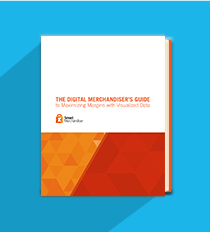
When you’re managing an eCommerce storefront, the visual representation of products is of utmost importance. And while there are several different types of visual merchandising software available for purchase, one of the difficulties involved in choosing the right software is finding one that balances a visual layout with the necessary analytics.
In that respect we’ll be looking at current trends in online shopping, as well as visual merchandising software platforms and what they offer merchandisers.
Current Online Shopping Trends
Online shopping and eCommerce saw a resurgence during 2014’s Thanksgiving week sales period. Per IBM’s Digital Analytics Benchmark Hub, "Cyber Monday remained the busiest online shopping day of the holiday season. Online sales grew 8.5 percent compared to 2013, with mobile sales up 27.6 percent year-over-year."
The notable, and sizable, increase in mobile sales is especially telling, with iOS devices having double the traffic of Android-based systems and claiming four times the sales. In general, the ‘Cyber Week’ from Thanksgiving through Cyber Monday showed strong sales as noted by IBM “[...] overall online sales increased 12.6 percent, with mobile sales up 27.2 percent compared to the same period in 2013.”
Software Platforms and Offerings
Visual merchandising has historically been a largely offline discipline, with applications and software focused on helping retail brands organize product displays within a storefront to maximize sales revenue. But with the growth in contribution of the online channel towards the total sales revenue of many of the world’s largest and most innovative brands, the traditionally offline practice of visual merchandising is being applied to online storefronts. Here are some of the more innovative visual merchandising applications available, whether focusing on more traditional offline merchandising or online counterparts.
Planogram Builder: From z.visuel offers a unique take on visual merchandising software. Their software offers a full 3D representation of your products on a virtual environment that mimics a traditional store shelving layout. It also offers real time tools to improve sales. It suggest store layouts based on sales, profit margins, and turnover projection. Reports can be generated in MS Office and all pertinent data is stored in an easily editable point of sale (POS) central database.
Tex-Store: From Koppermann is a slightly more advanced take on the 3D product representation idea. While some visual merchandising software only offer products on shelves Tex-Store offers an entire interactive store. Using this type of software you can easily create a fully interactive virtual space that customers move through. Plus the software automatically tracks sale volume and product supply allowing to track and highlight popular products.
Fits.me: Fits.me (recently merged with Clothes Horse) offers a unique visual element with a virtual dressing room. For clothing this can greatly increase customer satisfaction and reduce return expense, as Fits.me noted, “Our best verified impact on garment return rates is to generate a reduction in fit-related returns of 77%."
Smart Merchandiser: Smart Merchandiser is taking a fresh approach to online visual merchandising, providing retailers with a drag-and-drop catalog management interface that enables intelligent produce placement decisions around meaningful social, sales, and inventory metrics. One Smart Merchandiser customer reported a 30% increase in productivity. This improvement reduced the time associated with daily task management, which has empowered the organization to perform advanced testing and in-depth site personalization.
Focus on Mobile but Don’t Forget Desktops: Beyond mobile accessibility, having a mobile site optimized to deliver beautiful and easy shopping capabilities is key. The mobile sales platform continues to show impressive growth and reports revenue increases every year. To maximize customer reach, a focus on iOS compatibility is advisable; however, other platforms should not be ignored, as Android continues to mature as an operating system on mobile devices. However, the desktop remains a viable platform. Per data from IBM on Cyber Monday, PCs were responsible for 58.6 percent of traffic, 78 percent of sales, and had a 15.8 percent overall purchase value on orders.
The Best Visual Merchandising Software Depends on Your Needs: All visual merchandising software platforms have their pros and cons. Deciding which option will work best for your company depends on your organizations unique needs and goals.
For those needing to supply a 3D product layout, software with detailed reporting tools such as Planogram Builder can prove useful.
If you’re looking for a fully interactive store environment, Tex-Store offers greater versatility and ease of updating.
For the apparel seller, virtual dressing rooms such as Fits.me offer the ‘try on before buying’ element that virtual stores often lack increasing sales and reducing returns.
And for retailers looking to base their store layout decisions on social media analytics, real-time sales and inventory data, conversion rate information and the ability to actually see what a page layout looks like visually -- Zobrist's Smart Merchandiser is the best choice.
Improving profit margins is at the top of all eCommerce merchandiser’s to-do lists which is why we’ve created The Digital Merchandiser’s Guide to Maximizing Margins with Visualized Data eBook.
Download the eBook to learn more!


